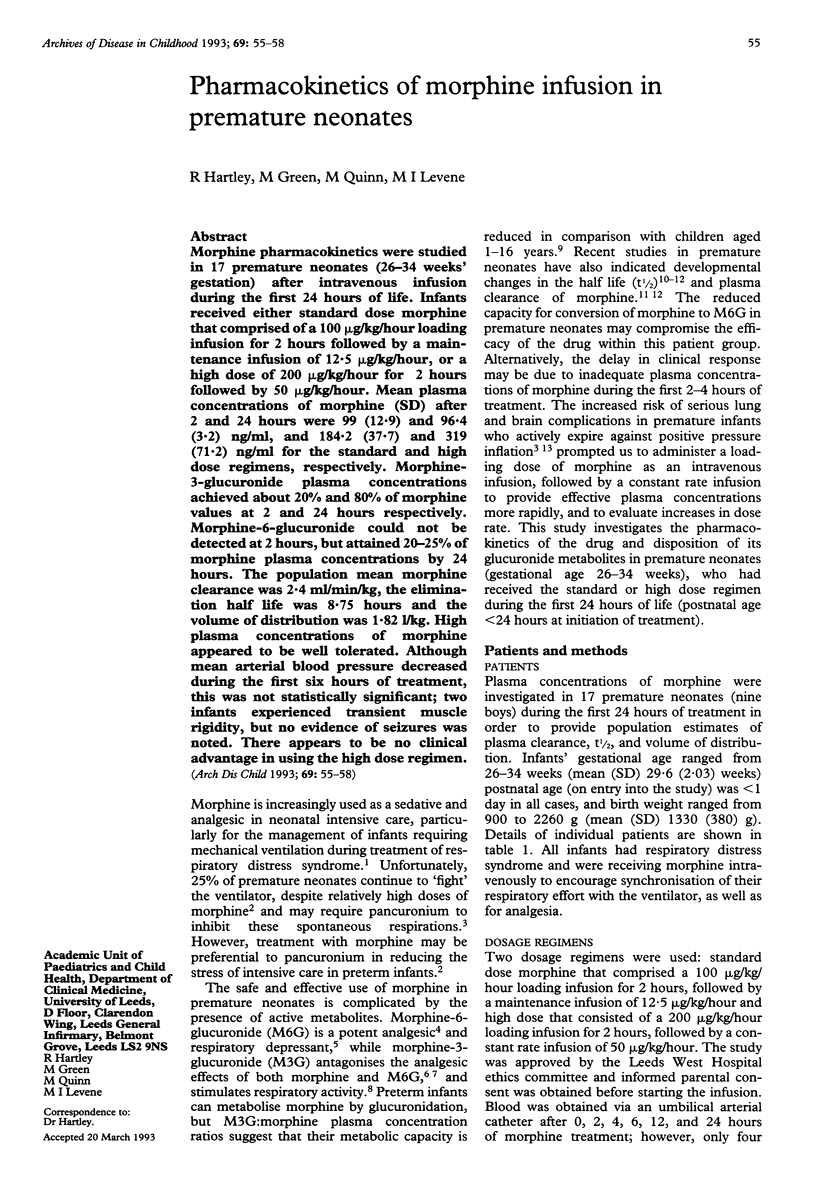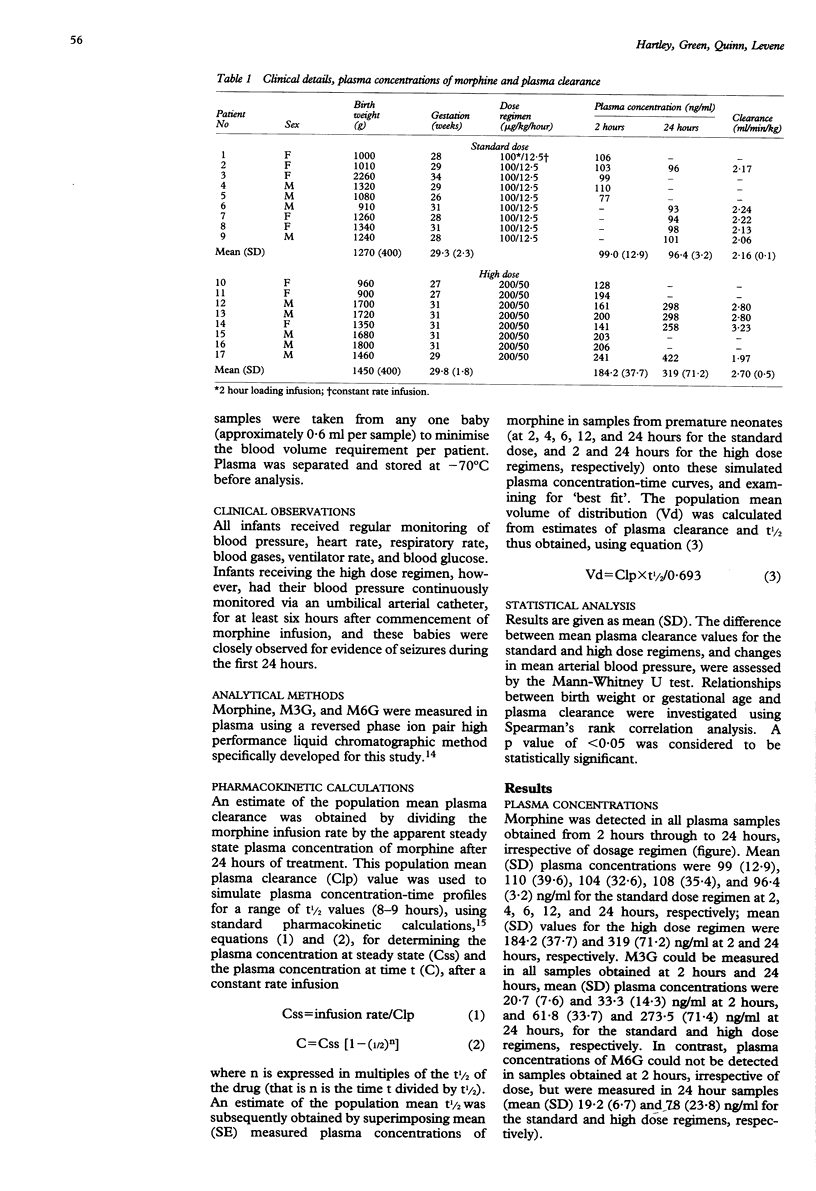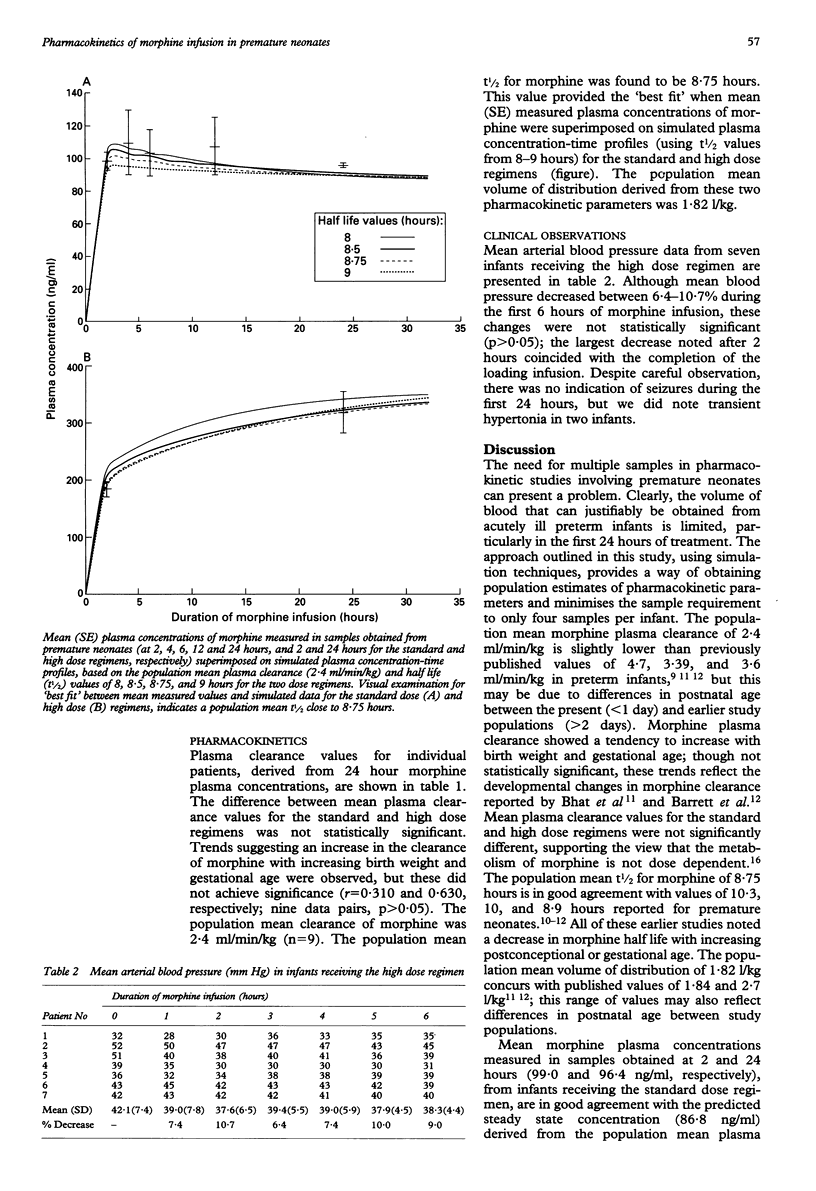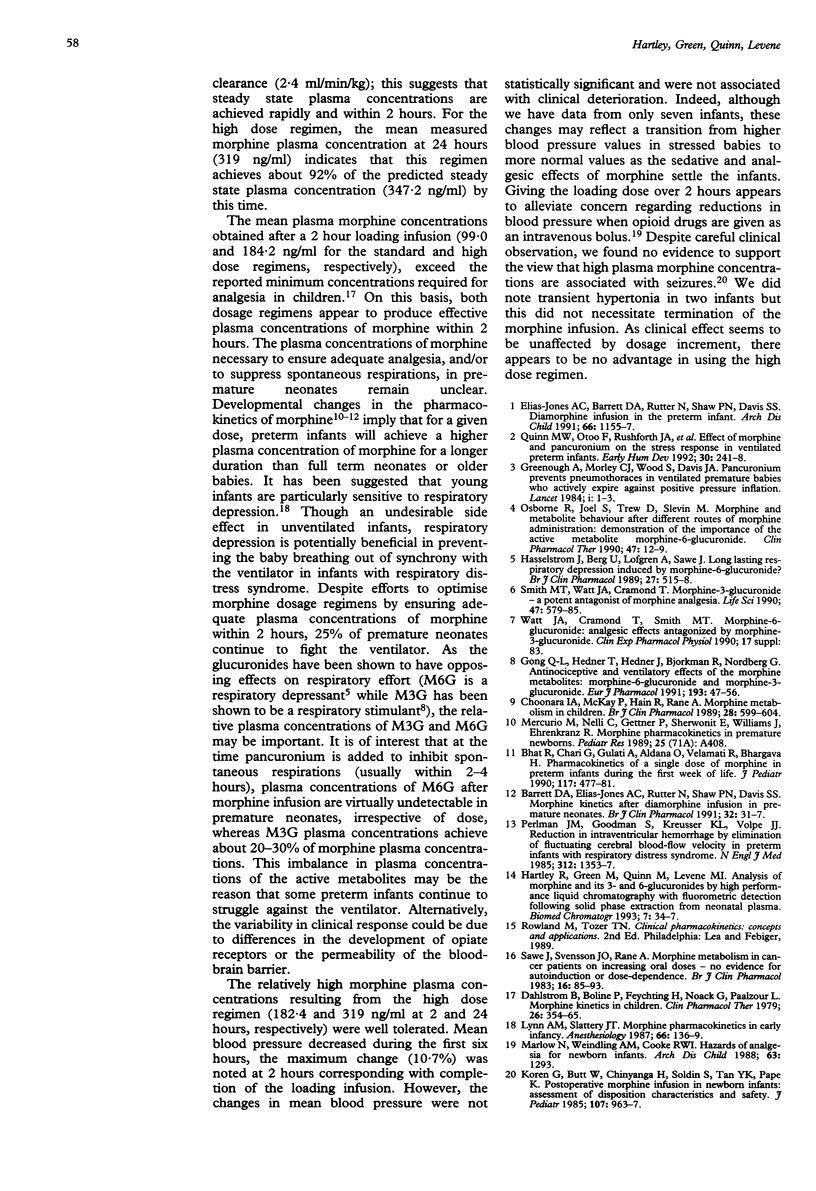Abstract
Morphine pharmacokinetics were studied in 17 premature neonates (26-34 weeks' gestation) after intravenous infusion during the first 24 hours of life. Infants received either standard dose morphine that comprised of a 100 micrograms/kg/hour loading infusion for 2 hours followed by a maintenance infusion of 12.5 micrograms/kg/hour, or a high dose of 200 micrograms/kg/hour for 2 hours followed by 50 micrograms/kg/hour. Mean plasma concentrations of morphine (SD) after 2 and 24 hours were 99 (12.9) and 96.4 (3.2) ng/ml, and 184.2 (37.7) and 319 (71.2) ng/ml for the standard and high dose regimens, respectively. Morphine-3-glucuronide plasma concentrations achieved about 20% and 80% of morphine values at 2 and 24 hours respectively. Morphine-6-glucuronide could not be detected at 2 hours, but attained 20-25% of morphine plasma concentrations by 24 hours. The population mean morphine clearance was 2.4 ml/min/kg, the elimination half life was 8.75 hours and the volume of distribution was 1.82 1/kg. High plasma concentrations of morphine appeared to be well tolerated. Although mean arterial blood pressure decreased during the first six hours of treatment, this was not statistically significant; two infants experienced transient muscle rigidity, but no evidence of seizures was noted. There appears to be no clinical advantage in using the high dose regimen.
Full text
PDF



Selected References
These references are in PubMed. This may not be the complete list of references from this article.
- Barrett D. A., Elias-Jones A. C., Rutter N., Shaw P. N., Davis S. S. Morphine kinetics after diamorphine infusion in premature neonates. Br J Clin Pharmacol. 1991 Jul;32(1):31–37. doi: 10.1111/j.1365-2125.1991.tb05609.x. [DOI] [PMC free article] [PubMed] [Google Scholar]
- Bhat R., Chari G., Gulati A., Aldana O., Velamati R., Bhargava H. Pharmacokinetics of a single dose of morphine in preterm infants during the first week of life. J Pediatr. 1990 Sep;117(3):477–481. doi: 10.1016/s0022-3476(05)81102-3. [DOI] [PubMed] [Google Scholar]
- Choonara I. A., McKay P., Hain R., Rane A. Morphine metabolism in children. Br J Clin Pharmacol. 1989 Nov;28(5):599–604. doi: 10.1111/j.1365-2125.1989.tb03548.x. [DOI] [PMC free article] [PubMed] [Google Scholar]
- Dahlström B., Bolme P., Feychting H., Noack G., Paalzow L. Morphine kinetics in children. Clin Pharmacol Ther. 1979 Sep;26(3):354–365. doi: 10.1002/cpt1979263354. [DOI] [PubMed] [Google Scholar]
- Elias-Jones A. C., Barrett D. A., Rutter N., Shaw P. N., Davis S. S. Diamorphine infusion in the preterm neonate. Arch Dis Child. 1991 Oct;66(10 Spec No):1155–1157. doi: 10.1136/adc.66.10_spec_no.1155. [DOI] [PMC free article] [PubMed] [Google Scholar]
- Gong Q. L., Hedner T., Hedner J., Björkman R., Nordberg G. Antinociceptive and ventilatory effects of the morphine metabolites: morphine-6-glucuronide and morphine-3-glucuronide. Eur J Pharmacol. 1991 Jan 25;193(1):47–56. doi: 10.1016/0014-2999(91)90199-z. [DOI] [PubMed] [Google Scholar]
- Greenough A., Wood S., Morley C. J., Davis J. A. Pancuronium prevents pneumothoraces in ventilated premature babies who actively expire against positive pressure inflation. Lancet. 1984 Jan 7;1(8367):1–3. doi: 10.1016/s0140-6736(84)90177-6. [DOI] [PubMed] [Google Scholar]
- Hartley R., Green M., Quinn M., Levene M. I. Analysis of morphine and its 3- and 6-glucuronides by high performance liquid chromatography with fluorimetric detection following solid phase extraction from neonatal plasma. Biomed Chromatogr. 1993 Jan-Feb;7(1):34–37. doi: 10.1002/bmc.1130070109. [DOI] [PubMed] [Google Scholar]
- Hasselström J., Berg U., Löfgren A., Säwe J. Long lasting respiratory depression induced by morphine-6-glucuronide? Br J Clin Pharmacol. 1989 Apr;27(4):515–518. doi: 10.1111/j.1365-2125.1989.tb05401.x. [DOI] [PMC free article] [PubMed] [Google Scholar]
- Koren G., Butt W., Chinyanga H., Soldin S., Tan Y. K., Pape K. Postoperative morphine infusion in newborn infants: assessment of disposition characteristics and safety. J Pediatr. 1985 Dec;107(6):963–967. doi: 10.1016/s0022-3476(85)80205-5. [DOI] [PubMed] [Google Scholar]
- Lynn A. M., Slattery J. T. Morphine pharmacokinetics in early infancy. Anesthesiology. 1987 Feb;66(2):136–139. doi: 10.1097/00000542-198702000-00005. [DOI] [PubMed] [Google Scholar]
- Marlow N., Weindling A. M., Cooke R. W. Hazards of analgesia for newborn infants. Arch Dis Child. 1988 Oct;63(10):1293–1293. doi: 10.1136/adc.63.10.1293. [DOI] [PMC free article] [PubMed] [Google Scholar]
- Osborne R., Joel S., Trew D., Slevin M. Morphine and metabolite behavior after different routes of morphine administration: demonstration of the importance of the active metabolite morphine-6-glucuronide. Clin Pharmacol Ther. 1990 Jan;47(1):12–19. doi: 10.1038/clpt.1990.2. [DOI] [PubMed] [Google Scholar]
- Perlman J. M., Goodman S., Kreusser K. L., Volpe J. J. Reduction in intraventricular hemorrhage by elimination of fluctuating cerebral blood-flow velocity in preterm infants with respiratory distress syndrome. N Engl J Med. 1985 May 23;312(21):1353–1357. doi: 10.1056/NEJM198505233122104. [DOI] [PubMed] [Google Scholar]
- Quinn M. W., Otoo F., Rushforth J. A., Dean H. G., Puntis J. W., Wild J., Levene M. I. Effect of morphine and pancuronium on the stress response in ventilated preterm infants. Early Hum Dev. 1992 Oct;30(3):241–248. doi: 10.1016/0378-3782(92)90073-p. [DOI] [PubMed] [Google Scholar]
- Smith M. T., Watt J. A., Cramond T. Morphine-3-glucuronide--a potent antagonist of morphine analgesia. Life Sci. 1990;47(6):579–585. doi: 10.1016/0024-3205(90)90619-3. [DOI] [PubMed] [Google Scholar]
- Säwe J., Svensson J. O., Rane A. Morphine metabolism in cancer patients on increasing oral doses--no evidence for autoinduction or dose-dependence. Br J Clin Pharmacol. 1983 Jul;16(1):85–93. doi: 10.1111/j.1365-2125.1983.tb02148.x. [DOI] [PMC free article] [PubMed] [Google Scholar]


